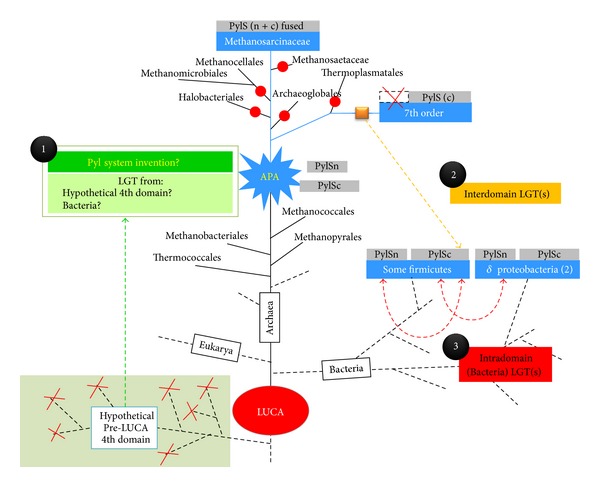Figure 4.

Proposed scenarios for the origin and evolution of the pyrrolysine system. One of the various possible models leading to the genesis of APA, the ancestral Pyl-coding archaeon, is schematized. This model supports less LGTs than previously proposed ones. APA (blue star) emerged in the Euryarchaeota (black circle no. 1) after the birth of the methanogenesis and was an ancestor of the Methanosarcinalesand/or of the Thermoplasmata-related 7th order of methanogens. Only the hypothesis of a common ancestor of both Methanosarcinalesand Thermoplasmata-related 7th order of methanogens is depicted here (see text for an alternative model with APA as a more recent ancestor, of the Methanosarcinalesor of the Thermoplasmata-related 7th order of methanogens, but not both). The putative genesis of APA (green boxes) relies either from an archaeal invention (Box 1), from a bacterial contribution, or from a whole functional system acquired from a hypothetical pre-LUCA 4th domain of life. APA was therefore likely a methanogenic archaeon performing both a methanol-H2-dependent methylotrophic methanogenesis and a hydrogenotrophic one. The Pyl system was vertically inherited (symbolized by large blue lines) to Methanosarcinaceae and to the 7th methanogenic order and was lost several times independently on various branches, including methanogenic ones (red dots). Due to the closest relationship of the Pyl system (orange square) between the 7th order and bacteria, at least one LGT is supposed to have occurred from a 7th order ancestor (before the loss of the pylSc gene in this lineage), likely to a Firmicute(no. 2, orange arrow). Other LGTs from the 7th order to Bacteria (i.e., a deltaproteobacterium) are also conceivable. In a third period, intradomain LGT(s) could have originated next putatively among Firmicute and/or into a deltaproteobacterium (no. 3, red arrows). Pyl-coding organisms are symbolized in blue boxes. The nature of the PylRS is depicted with each Pyl-containing group in grey boxes and is either formed by a unique PylS (Methanosarcinaceae), a split complete version (PylSc//PylSn in bacteria), or a unique PylSc form (7th methanogenic order).
